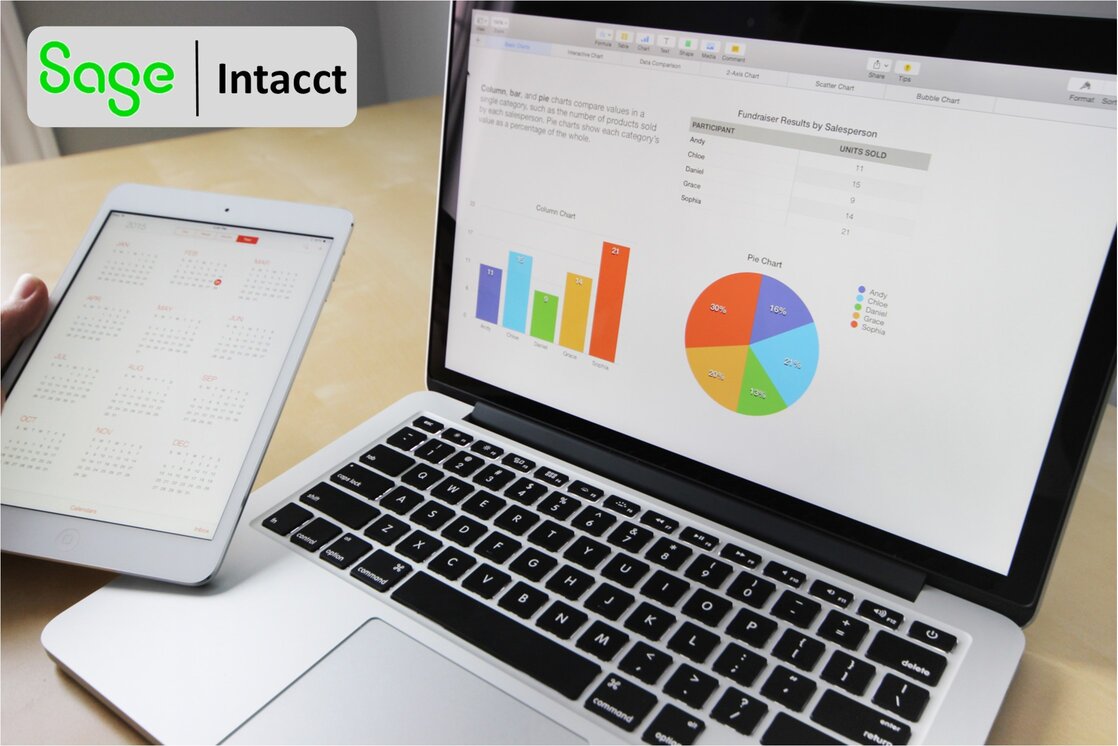Excel spreadsheets are heavily relied upon in financial organisations and departments, but your business might face significant risks. Find out more.
While spreadsheets like Excel have long been the go-to choice for many, it's becoming increasingly evident that they may not be the optimum solution for today’s complex financial needs. The limitations of spreadsheets are particularly acute for growing businesses that require more scalable and efficient systems.
Small enterprises and freelancers might find spreadsheets adequate for basic bookkeeping and accounting. But as your business evolves, so do your financial management requirements. Adopting sophisticated solutions such as cloud-based financial software addresses these limitations and propels your business towards long-term success. However, opting for a platform like Sage Intacct can offer more than just accounting solutions; it can be a strategic asset for your financial operations.
This article aims to delve deeply into the inherent disadvantages of relying on spreadsheets for financial tasks. It also provides compelling reasons why switching to a cloud-based financial solution like Sage Intacct could be a transformative decision for your organisation.
The History of Spreadsheets in Finance
 Spreadsheets have had a long-standing relationship with the world of finance, tracing their origins back to paper ledgers used for accounting and bookkeeping. With the advent of digital spreadsheets, spearheaded by software like Lotus 1-2-3 and later Microsoft Excel, finance professionals found a tool that seemed tailor-made for their needs. A digital grid to calculate, sort, and analyse data offered a quantum leap from manual processes.
Spreadsheets have had a long-standing relationship with the world of finance, tracing their origins back to paper ledgers used for accounting and bookkeeping. With the advent of digital spreadsheets, spearheaded by software like Lotus 1-2-3 and later Microsoft Excel, finance professionals found a tool that seemed tailor-made for their needs. A digital grid to calculate, sort, and analyse data offered a quantum leap from manual processes.
Over the decades, spreadsheets have become ubiquitous in financial settings. From basic tasks like budgeting to more complex functions such as financial modelling, spreadsheets appeared to offer a versatile, all-in-one solution. Yet, despite these benefits, their usage in the current finance landscape raises some significant concerns. While they were once a revolutionary tool, the requirements of modern finance have evolved to a level of complexity that often exceeds what spreadsheets can efficiently handle.
By understanding the history and initial appeal of spreadsheets, it becomes easier to appreciate their current limitations and the necessity for more advanced solutions in today's financial environment.
The 5 Types of Financial Spreadsheets Used
Spreadsheets have proven to be versatile tools for a range of financial operations. From tracking expenditures to projecting future revenues, these digital workbooks are widely used across the finance industry. Yet, as we dig deeper into the specific types of financial spreadsheets commonly employed, it becomes apparent that each serves a specific function but also carries inherent limitations.
For finance teams aiming for efficiency and scalability, recognising these limitations is the first step towards embracing more advanced solutions.
In this section, we explore five commonly used types of financial spreadsheets and discuss their respective roles and drawbacks.
- 1. Budget
-
Budget spreadsheets have been foundational tools for planning and monitoring fiscal activities. They help businesses set revenue goals, allocate resources, and control costs. However, their main limitation lies in the inability to adapt to real-time data updates.
As a result, businesses relying solely on budget spreadsheets find themselves mired in inefficiencies. They are unable to dynamically adjust plans or make data-driven decisions on-the-fly, which can be a significant drawback in today's fast-paced business environment.
- 2. Income Statements
-
Income statement spreadsheets are designed to provide a snapshot of a company’s profitability over a specific period. They list revenues, costs, and expenses to calculate net income. While functional for periodic reporting, they are cumbersome and prone to errors when dealing with complex revenue streams or multiple cost centres.
The risk of incorrect data inputs or formula errors can lead to significant reporting inaccuracies. These inaccuracies pose a risk to financial compliance and strategic decision-making, making them less reliable for today's complex financial landscapes.
- 3. Cash Flow Analysis
-
Cash flow spreadsheets are frequently used to monitor liquidity, tracking income and expenditures over time. They serve as essential tools for understanding the immediate financial health of a business. Yet, they fall short in their ability to accurately forecast and model future cash flows, especially in fluctuating markets.
Minor errors in cash flow analysis can lead to poor liquidity management. The resulting miscalculations affect a company's ability to meet its short-term obligations, thereby compromising its financial stability.
- 4. Financial Modelling
-
Financial modelling spreadsheets are complex by nature, designed to simulate various business scenarios and financial outcomes. They are robust for scenario analysis but vulnerable to formula errors, making them exceedingly complex and difficult to manage.
This level of complexity makes these spreadsheets hard to audit, update, or even fully comprehend. Such challenges raise concerns about their reliability and accuracy, further questioning their suitability in today's intricate financial settings.
- 5. Accounts Receivable and Payable
-
Spreadsheets for accounts receivable and payable are integral for managing a business's cash flow, as they track outstanding invoices and pending payments. However, they become difficult to manage as the volume of transactions increases, often leading to inaccuracies.
The challenges of keeping these spreadsheets up-to-date make them less reliable for effective cash flow management. Inaccurate tracking of receivables and payables can result in missed payments or overlooked invoices, creating financial discrepancies that could be avoided with more advanced solutions.
The Main Disadvantages of Using Spreadsheets in Finance Teams
 While these spreadsheets serve important functions, they come with drawbacks that modern finance teams cannot afford to ignore. As businesses scale and financial operations become more complex, the limitations of spreadsheets become more pronounced.
While these spreadsheets serve important functions, they come with drawbacks that modern finance teams cannot afford to ignore. As businesses scale and financial operations become more complex, the limitations of spreadsheets become more pronounced.
The following are some of the main disadvantages that make spreadsheets an increasingly obsolete choice for finance teams seeking to be agile, efficient, and accurate.
Lack of real-time data
Spreadsheets are often manually updated, meaning they don't provide real-time data. This lag can significantly impact decision-making processes, as finance teams need up-to-the-minute information to make informed choices.
Moreover, outdated information can lead to suboptimal financial strategies, disadvantaging organisations in a competitive marketplace. This limitation becomes increasingly unacceptable in an era where data-driven decisions are crucial.
Error-prone
“To err is human”, as the saying goes, but when it comes to business financials, errors can lead to critical complications. Manual data entry increases the risk of human errors. Mistakes can range from simple typographical errors to more severe miscalculations, affecting the accuracy of financial reports and forecasts.
The issue is exacerbated when multiple team members are involved, as it becomes difficult to track changes or identify the source of an error. This lack of accountability can lead to significant issues, including compliance risks and financial losses.
Scalability issues
Spreadsheets may suffice for small businesses with simple financial needs, but they become increasingly unmanageable as a company grows. They struggle to handle large volumes of data and complex calculations, leading to slower load times and inefficiency.
Even worse, as your business evolves, these spreadsheets can become labyrinthine monstrosities that are slow and incredibly challenging to navigate, making them impractical for agile business operations.
Security concerns
Spreadsheets often lack robust security features, making them vulnerable to unauthorised access and data breaches. Sensitive financial data can be easily compromised, posing a significant risk to the organisation.
Furthermore, tracking who has accessed or modified a spreadsheet is challenging, reducing accountability and increasing the risk of internal malfeasance. For businesses concerned with data integrity and security, spreadsheets present a glaring vulnerability.
Limited analytical tools
While spreadsheets offer basic analytical capabilities, they fall short when it comes to advanced data analysis and visualisation. Finance teams need sophisticated tools to perform in-depth analyses, create interactive dashboards, and generate insights that can guide business strategy.
Relying on spreadsheets for these tasks not only restricts the depth of analysis but also consumes valuable time that could be spent on more strategic activities. As a result, businesses miss out on the opportunity to leverage their data fully.
The Benefits of Switching to a Cloud-Based Finance Solution
 Transitioning from spreadsheets to a cloud-based finance solution may initially seem daunting, but the advantages far outweigh any perceived inconveniences. Businesses across various industries recognise the need for a scalable, secure, and efficient system for managing their finances.
Transitioning from spreadsheets to a cloud-based finance solution may initially seem daunting, but the advantages far outweigh any perceived inconveniences. Businesses across various industries recognise the need for a scalable, secure, and efficient system for managing their finances.
Here are five key benefits that make cloud-based solutions indisputably superior to traditional spreadsheets for modern finance teams.
Real-Time Data and Analytics
Unlike spreadsheets, cloud-based solutions offer real-time data and analytics capabilities. Finance teams can make quicker and more informed decisions without the lag of manual updates.
Moreover, these solutions often come equipped with advanced analytical tools. These tools facilitate comprehensive data analysis, empowering businesses to derive meaningful insights to guide strategy and decision-making.
Scalability
One of the most significant advantages of cloud-based finance solutions is their ability to scale with your business effortlessly. As your organisation grows, the system can easily adapt to handle increased data volumes and more complex financial operations.
This flexibility eliminates the need for frequent system upgrades or migrations, saving time and financial resources. It's a forward-thinking solution that accommodates both your current needs and future growth.
Enhanced collaboration
Cloud-based solutions facilitate enhanced collaboration among team members. Multiple users can work on the same data set simultaneously without the risk of data corruption or loss.
This fosters a more agile and productive environment where finance teams can work seamlessly with other departments. Communication barriers break down, enabling faster problem-solving and streamlined operations.
Robust security
Security remains a top priority for any organisation, and cloud-based solutions are designed with this in mind. They come with robust security features, including data encryption and user authentication protocols, to protect sensitive financial information.
These advanced security measures give businesses the peace of mind that their data is secure, resolving the vulnerabilities commonly associated with spreadsheets. Moreover, cloud-based systems often have comprehensive audit trails, ensuring full accountability.
Automation and efficiency
Automation is one of the standout features of cloud-based finance solutions, enabling tasks such as invoicing, expense tracking, and reporting to be automated. This frees up valuable time for finance teams, allowing them to focus on strategic tasks rather than routine administrative work.
By automating repetitive processes, cloud-based solutions increase efficiency and reduce the risk of human error. It’s a transformative change, allowing finance teams to contribute meaningfully to business success.
Biggest Advantages of Sage Intacct for Businesses
Sage Intacct is an industry-leading platform that offers unique features tailored to meet the evolving demands of modern businesses. The following highlights reveal why Sage Intacct stands out from other cloud-based solutions and, more importantly, why it's an ideal alternative to spreadsheets for your finance team.
- 1. Customisability and modularity
-
What sets Sage Intacct apart is its customisability. Businesses can tailor the platform to match their specific financial workflows and reporting needs. This high level of customisation extends to its modular approach, where businesses can start with basic functionalities and seamlessly add new modules as they grow.
This modular design is especially advantageous for organisations that experience seasonal fluctuations or rapid growth, making it a dynamic solution for today's ever-changing business landscape.
- 2. Compliance and regulation
-
For businesses operating in regulated industries, Sage Intacct offers a considerable advantage. The platform includes features designed to assist with compliance, from tax calculations to financial reporting standards like GAAP in the US and IFRS, used by companies internationally.
Sage Intacct takes the hassle out of compliance management with various built-in compliance tools and continuous updates to reflect regulatory changes. It’s an invaluable resource that reduces the risk of non-compliance and potentially costly penalties.
- 3. Seamless integration with other systems
-
One of Sage Intacct's standout features is its ability to integrate seamlessly with other business-critical applications, whether CRM systems like Salesforce or e-commerce platforms like Shopify. This interoperability not only eliminates data silos but also creates a unified business ecosystem.
Sage Intacct encourages data-driven decision-making across the entire organisation by breaking down the walls between different departments and systems. This approach sets the stage for more streamlined operations and increased profitability.
- 4. Advanced reporting capabilities
-
While many cloud-based solutions offer reporting tools, Sage Intacct takes it to the next level with its advanced reporting capabilities. The platform allows users to create intricate, multi-dimensional reports that provide deeper insights into financial performance.
With the power to dissect data in multiple ways from various angles, finance teams are equipped to make more strategic decisions. This advanced reporting capability is a marked improvement over the simplistic analysis and visualisation options available in spreadsheets.
- 5. Exceptional user experience
-
User experience is often an overlooked factor when selecting a finance system, but Sage Intacct places a premium on creating an intuitive, user-friendly interface. Its design reduces the learning curve for new users, enabling quicker adoption and more efficient use of its features.
The focus on user experience extends to its customer support, which is renowned for being responsive and helpful. Working with companies like Accord Consulting is a great way to enjoy the power of Sage Intacct and amazing customer support. This complete package ensures businesses can maximise the benefits of Sage Intacct with minimal disruption to their daily operations.
The Key Automation Features of Sage Intacct
As we’ve highlighted, Sage Intacct is a powerful ally that automates crucial financial tasks. Office automation systems are absolute necessities for businesses that seek to transform their finance departments into proactive, strategic units. Sage Intacct’s automation features are game-changers in the realm of financial management. They enable finance teams to take a more strategic role in their organisations, leaving the tedious, error-prone tasks to a system that handles them precisely and reliably.
With that said, here are three automation features within Sage Intacct that you should know about.
Automated multi-entity consolidation
One of the most cumbersome tasks for finance teams is consolidating financial data across multiple business units or locations. Sage Intacct's automated multi-entity consolidation tool addresses this complexity head-on.
This feature allows you to pull together financial data from various entities automatically, ensuring a consistent and streamlined consolidation process. Moreover, it offers robust inter-entity transaction capabilities, facilitating the seamless allocation of funds or costs between entities. It's a feature that can save countless hours and reduce the scope for manual error, thus delivering on the promise of automated financial management.
Recurring billing and revenue recognition automation
Managing recurring billing and revenue recognition manually can be a convoluted process that's ripe for mistakes. Sage Intacct offers a dedicated feature that automates these functions, simplifying the entire cycle from invoicing to revenue recognition.
The automation not only ensures accuracy but also adheres to compliance standards, which can be particularly critical for businesses subject to stringent accounting regulations. By reducing manual involvement, this feature also allows finance teams to reallocate their time to more value-added tasks, serving as a catalyst for operational efficiency.
Expense management automation
Expense management is integral to financial operations but is often fraught with inefficiencies and delays when handled manually. Sage Intacct automates the expense management process from end to end.
The platform allows for easy input and approval of expenses, linking directly to project accounting and other financial modules. Automated approval workflows expedite the process, while built-in analytics provide actionable insights into spending patterns. It's an automation feature that improves operational efficiency and enhances visibility into cost management.
Final Thoughts
You've taken a comprehensive journey through the limitations of traditional spreadsheets, the inefficiencies they bring to modern finance teams, and the advantages of transitioning to a cloud-based solution like Sage Intacct. With robust automation features, customisability, and a focus on compliance, Sage Intacct is more than just a tool — it's a strategic asset for your business.
As you weigh the pros and cons, remember that the finance department is not just a record-keeping unit; it's a cornerstone that influences the strategic direction of your entire organisation. Financial software like Sage Intacct allows your finance team to evolve from mere bookkeepers to indispensable strategic advisors, driving your business towards sustainable growth and success.
So, why settle for outdated spreadsheets that tether your finance team to time-consuming, error-prone tasks? Don't let another day go by clinging to outdated processes. Elevate your financial management to new heights with Sage Intacct. Take the first step towards a more efficient, streamlined future for your business by experiencing Sage Intacct first-hand.
Book your Sage Intacct discovery call today